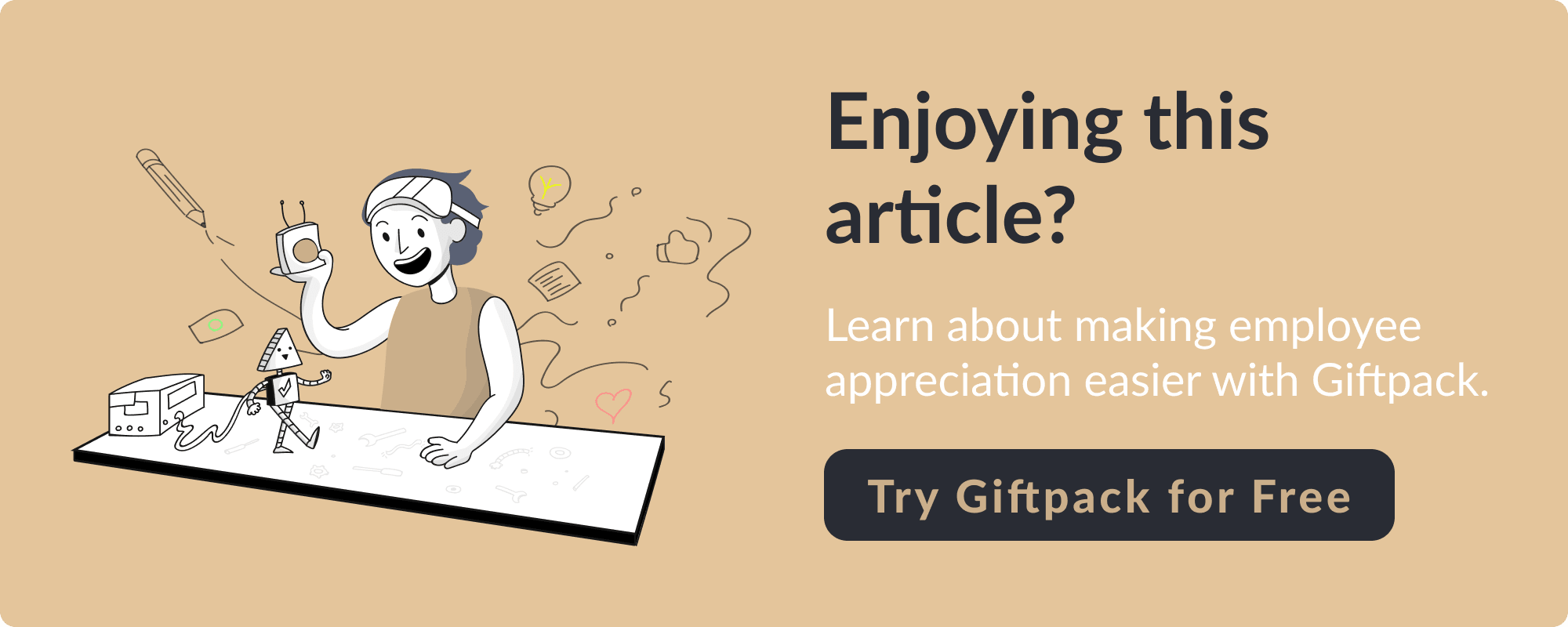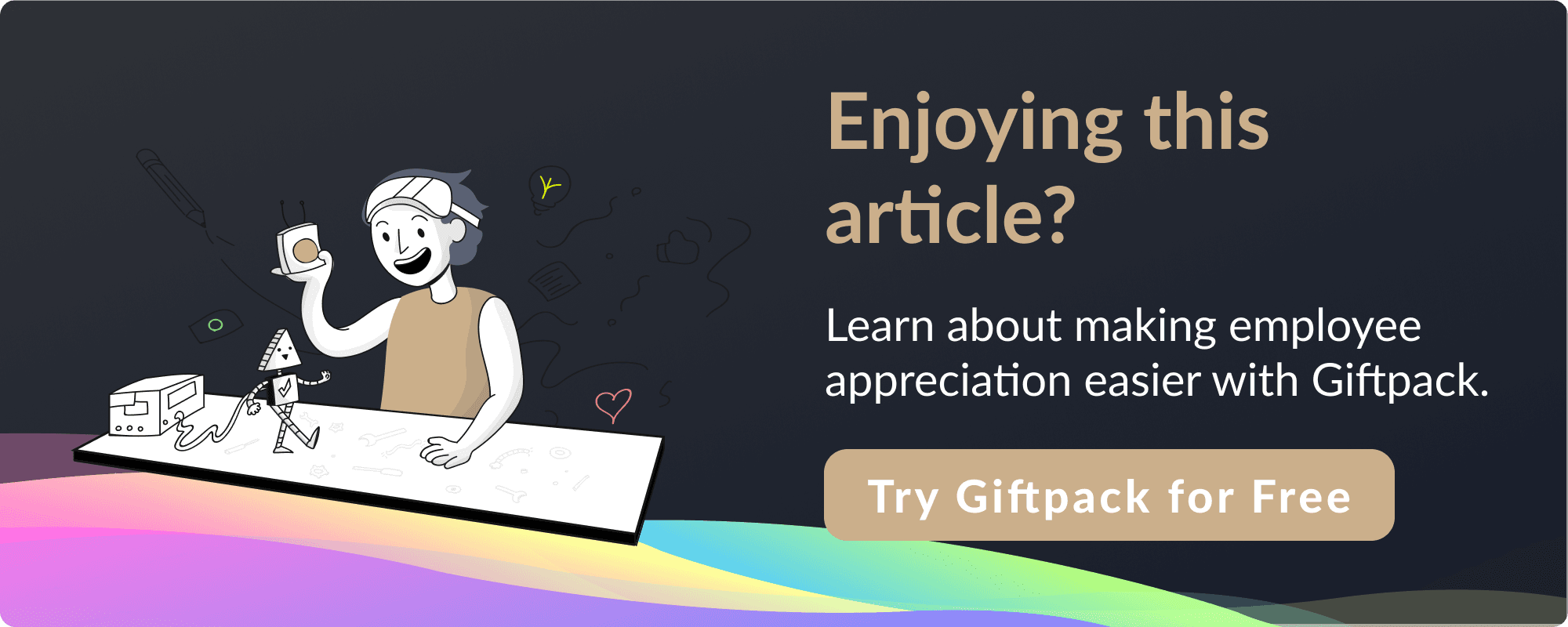
Starting a new job can feel like stepping into a whirlwind. There’s excitement, yes, but also a whole lot of nerves. As an employer, making this transition as smooth as possible is crucial. That's where Inclusive Onboarding comes in. This approach isn’t just about getting paperwork done. It’s about setting the stage for everyone to thrive, regardless of background or experience level. Want to know the best ways to pull this off? You’re in the right place. This article will give you a rundown of the best practices for onboarding new employees so that you can create a welcoming environment from day one.
Company branded swag can make a big difference. Giftpack has some great options to help your new team members immediately feel at home.
19 Best Practices For Onboarding New Employees

1. Kickstart with Company Swag
New hires are excited to represent their new employer, but gathering any number of company branded swag often takes a while. If you want to celebrate your new hires, show them they are integrated from day one with company swag. There are dozens, if not hundreds, of ways to enjoy swag.
Some employees may want a hat, while others enjoy a long-sleeve t-shirt. Instead of sending the swag you enjoy to team members, you could give out swag based on employee preferences by using Giftpack's software to send personalized gifts to employees.
2. Deliver a Thoughtful Care Package
A care package is an easy way to make your employees happy. It’s private and personalized enough to make employees happy about receiving it. The care package’s contents depend on your organization and the recipient. For example, if you’re giving snacks or food, ensure you know what your new hire is allergic to or doesn’t eat.
If the new employee is moving to a new city, you could include helpful items like a city guide or a certificate from a local restaurant. In addition, you can create a list of:
• Attractions
• Restaurants
• Things to do that seasoned workers recommend
Giftpack can help you send care packages to remote hires if you don't see them in person during onboarding.
3. Map Out the Onboarding Journey
Create a structured roadmap outlining the activities and information new employees need to know before their first day, during their first week, 90 days, and year. This plan should be comprehensive and tailored to the organization's specific needs. Designing a plan for each key onboarding phase involves breaking the onboarding process into specific stages and outlining each phase's activities, resources, and goals.
Before The First Day
Send new hires a welcome email or package containing important information such as their start date, dress code, and pre-employment paperwork. Provide access to necessary systems, tools, and resources, such as:
• Email accounts
• Project management software
• Training materials
Assign pre-reading or pre-training materials to familiarize new hires with the company's culture, values, and policies.
On The First Day
Schedule a comprehensive orientation session introducing new hires to the organization's mission, vision, and values. Conduct a tour of the office or a virtual office tour, highlighting key areas and introducing new hires to their colleagues. Assign a buddy or mentor to guide new hires through their first day, answer questions, and provide support.
In The First Week
Provide an overview of the team's structure, roles, and responsibilities, including introductions to key team members. Offer training sessions or workshops on the organization's essential tools, processes, and systems. Assign small projects or tasks to allow new hires to apply their skills and gain hands-on experience.
In The First 90 Days
Set clear goals and expectations for new hires, outlining what they should achieve within the first 90 days.
• Schedule regular check-ins with managers or mentors to provide feedback, address concerns, and offer guidance.
• Offer opportunities for new hires to attend team meetings, cross-functional sessions, or training programs to broaden their understanding of the organization.
• Conduct performance reviews or evaluations within the first year to assess new hires' progress and provide constructive feedback.
• Offer opportunities for professional development, such as training programs, workshops, or conferences.
• Encourage new hires to set long-term goals and develop a career plan.
4. Tailor the Onboarding Experience
You’ll want to create an onboarding program broadly the same for each new starter, covering IT setup, orientation, organizational values, strategy, and culture, for example. The most crucial elements will be tailored to the division, department, or team in which the new employee will work. These might include:
• Learning that is specific to that role,
• Function or department and is suited to the employee’s learning style,
• Policies and HR documentation
• Objectives
• Goals and performance management
• Reward and benefits information
Which may differ by seniority level, start times and flexible working arrangements, and safety information and procedures. A personalized experience will make the new starter feel more valued and better supported, and it’s also likely to be more effective than a standardized induction program.
5. Infuse Onboarding with Company Culture
Incorporate activities like team-building exercises, virtual meet-and-greets, or storytelling sessions to introduce new hires to the organization's culture. This helps them feel connected and aligned with the company's values and mission.
Welcome Package
Create a welcome package for new hires that includes items representing your company culture, such as branded merchandise, company values cards, or a welcome letter from the CEO. This will set the tone and introduce new hires to the unique aspects of your culture from the start.
Culture Presentation
Dedicate a portion of the onboarding program to a culture presentation. This can be delivered by a senior leader or a representative from the people operations team. The presentation should cover the company's mission, vision, values, and key cultural aspects. Use real-life examples and stories to illustrate how these values are lived within the organization.
Culture Handbook
Develop a culture handbook or guide that provides an in-depth overview of your company's culture. Include information about the history, values, rituals, and traditions that shape your organization. This handbook can serve as a reference for new hires to understand and align with the company culture.
Cultural Immersion Activities
Incorporate interactive activities into the onboarding process that allow new hires to experience and engage with the company culture. This can include team-building exercises, group discussions, or role-playing scenarios that reflect the values and behaviors you want to promote.
Cross-Functional Introductions
Facilitate introductions and interactions between new hires and employees from different teams or departments. This will expose new hires to diverse perspectives and allow them to witness how the company culture manifests across various functions.
Culture Ambassador Sessions
Organize sessions where employees from different levels and roles share their experiences and perspectives on the company culture. These sessions can be in panel discussions, Q&A sessions, or informal coffee chats. This provides new hires with multiple viewpoints and reinforces the importance of culture throughout the organization.
Ongoing Culture Integration
Ensure the company culture is consistently reinforced beyond onboarding. Incorporate culture-related activities, events, or initiatives into regular team meetings, performance reviews, and company-wide communications. This helps new hires see that culture isn't just a one-time introduction but an integral part of the organization's DNA.
6. Wellness Meets Onboarding
Onboarding can be intense, so consider including a wellness challenge to support new hires' mental and physical well-being. This will let them know it’s okay to feel overwhelmed and encourage self-care. Create a list of activities, such as a walk, journaling, or a family dinner, and ask new hires to complete a few. Incentivize participation with rewards, using tools like Nectar to help manage the challenge.
7. Create Social Connections with Coffee or Tea Dates
Organizing coffee or tea meetups between new hires and their managers or team members helps foster early connections. These informal meetups allow seasoned employees to get to know new hires personally. You can make this a recurring event or consider providing membership cards for a local café to encourage these social interactions regularly.
8. Make New Hires Feel Welcome with In-Person Introductions
Starting a new job can feel daunting, especially if someone doesn’t know anyone yet. To welcome new hires, organize structured in-person introductions, one-on-one or in group settings. For hybrid teams, remote employees can be introduced via video calls, creating a welcoming environment even from afar.
9. Listen and Learn with Entry Interviews
Want to make your new hire feel heard and a part of the company? Conduct entry interviews! During these interviews, you should ask the new hire what the company can do to support them throughout their employment.
Entry interviews can open the company’s eyes to how it can better motivate and retain employees. New hires might be hesitant to speak up, but entry interviews can make them speak their mind.
10. Act on New Hire Feedback
A good organization listens to its employees' opinions and welcomes their feedback. Ensure your organization is ready to collect feedback at essential stages of a new hire’s journey. Ask them how they feel about your onboarding process and whether they have enough resources to succeed in their new job. This will make the new staff feel listened to and integrated into the organization.
11. Pair New Hires with a Mentor
With the help of the employee’s supervisor, pick a mentor or buddy who will escort your new hire for the first few weeks or months, answering questions and helping them integrate. If needed, give the mentor time off from their other tasks. Ask other team members to help welcome and settle the employee.
12. Make Onboarding Fun with a Scavenger Hunt
Scavenger hunts are fun. Incorporating these events into your onboarding process and beyond can be enjoyable for your employees. Create a series of tasks and questions that expose new workers to the different areas of the company. Aside from increasing their familiarity with the different areas of the company, this activity can also be designed to make the new workers meet with all the other employees and learn what they do.
13. Continue Learning Opportunities Beyond Onboarding
One of the key benefits employees appreciate in their roles is the chance to learn and grow professionally. Leading companies see onboarding as more than an initial phase; they extend it over months or even the first year to foster continuous development. By providing ongoing learning opportunities, you set employees up for future roles and enhance their performance. Celebrate new hires by giving them credit for learning platforms like Udemy.
14. Gamify Their Onboarding Experience
Add gamification elements to make onboarding engaging. If your company has a culture of friendly competition, gamifying onboarding can be an effective way to integrate new employees into your culture. With tools like Nectar, you can reward new hires with points for completing various onboarding tasks, such as security training or setting up direct deposit. Establish a budget for onboarding challenges to keep costs manageable while keeping the experience motivating and enjoyable.
15. Conduct Regular Check-ins During Onboarding
In a new hire’s first month, schedule weekly check-ins with their manager and onboarding buddy. These check-ins help:
• Discuss onboarding progress.
• Remind new hires of important activities they have yet to complete.
• Identify whether they need help or advice on managing their workload.
Check-ins are also a good time to discuss expectations around employee performance and deliverables so that new employees don’t keep guessing if they’re doing a good job. If you expect customer service reps to attend a certain number of calls per week or sales reps to make a specific number of client calls per week, be explicit about these expectations.
Discuss key results employees must achieve, like winning X number of clients in a quarter or resolving X customer queries in a week. To help new hires ramp up:
• Set timelines around when you expect them to complete training.
• Work on their first live project.
• Start delivering results.
Once employees feel comfortable in their role, after their first month or two, you can transition to monthly check-ins.
16. Use Technology to Improve Onboarding Efficiency
Incorporating technology into the onboarding process can significantly improve its efficiency and effectiveness. Onboarding software can automate administrative tasks like:
• Document management
• Training modules
• Tracking progress
This streamlines the process, reduces paperwork, and ensures consistency in information delivery. Virtual onboarding sessions and video tutorials can introduce new hires to the:
• Company culture
• Policies
• Essential training
This is another field where augmented reality shines, delivering an immersive, hands-on experience during initial training. With AR, new hires can learn by doing without the associated risk of error. AR covers trainees, from occupational health and safety to fire training, and helps them acquire the necessary skills for particular positions. Technology enables seamless communication and collaboration between HR, managers, and new employees, creating a smooth onboarding experience even for remote or distributed teams.
17. Set Clear Expectations and Provide Training
To perform well, new employees must clearly understand their roles and responsibilities. Managers should communicate specific job expectations, key performance indicators, and success criteria during onboarding.
They should also provide ample training and resources to equip employees with the skills and knowledge necessary to excel in their roles. Offering on-the-job training, access to learning platforms, and mentorship opportunities can help employees develop competencies and feel more confident in their positions.
18. Foster Relationships for Better Onboarding
Onboarding is all about connection. For many employees, the most valuable aspect of their most recent onboarding experience was the human element of meeting people, forming social ties, and learning from their colleagues. New employees want relationships that make them feel supported, included, and respected.
They value candid feedback and clear communication, particularly from leaders and managers. They want to meet many people, ask questions, and receive mentoring from genuinely caring colleagues. New hires have the best onboarding experience when they respect their partners and trust that their coworkers are committed to excellence.
19. Monitor Progress and Offer Support Throughout Onboarding
The onboarding process doesn’t end on the first day or week. HR and managers should regularly check in with new employees to monitor their progress, address any challenges they may face, and offer ongoing support.
One-on-one meetings, feedback sessions, and performance reviews can provide valuable opportunities for employees to share their experiences and receive guidance. Organizations can foster a positive and supportive work environment by demonstrating a genuine interest in their growth and well-being, leading to higher job satisfaction and retention rates.

Related Reading
• Small Business Onboarding • Onboarding Remote Employees • Onboarding Phases • New Team Member Announcement • Onboarding Meeting • New Hire Onboarding Survey Questions • New Hire Orientation Survey • Onboarding and Training • Onboarding Goals
Why is The New Employee Onboarding Experience Important?

Setting the Stage for Success
A solid onboarding process immediately lays the groundwork for employee success. It’s more than just familiarizing new hires with company policies. It’s about making them feel like they belong and are valued.
When employees feel this way, they’re more likely to stick around and perform better. This positive start sets the tone for their career with the company, helping them align with its mission and goals.
Fueling Engagement and Productivity
Engaged employees are productive employees. A robust onboarding process ensures that new hires are engaged from day one, which leads to higher productivity levels. When employees feel supported and understand their role in the company, they’re more motivated to contribute. This reduces the time it takes for new hires to become fully productive and helps companies retain top talent.
Cutting Costs by Reducing Turnover
Onboarding can be expensive, but losing and replacing an employee is even higher. A poor onboarding experience is one of the main reasons employees leave early. Prioritizing a comprehensive onboarding process saves the company from the high costs associated with turnover and strengthens employee loyalty.
Building Confidence with Effective Training
Onboarding ensures that new hires are adequately trained and prepared for their roles. When [onboarding is paired with practical training], employees feel more confident in their abilities (https://teamstage.io/training-statistics/ ). This reduces the learning curve and minimizes errors early on. Companies that invest in onboarding and continuous training build a strong foundation for employee growth and development.
A Lasting First Impression
The first impression a company makes during the onboarding process is critical. It sets the stage for an employee’s entire journey with the company. A positive onboarding experience reassures new hires that they’ve made the right choice, while a poor experience can result in disillusionment and disengagement from the start.
Giftpack: Elevate Your Onboarding Experience
At Giftpack, we're here to make corporate gifting a breeze. Our client gifting service uses AI to create personalized gifts from a catalog of over 3.5 million products, ensuring a meaningful connection with your recipients. Try Giftpack's client gifting service for free today.

Measuring The Effectiveness Of Your Onboarding Program

Speeding Up Success: Time to Productivity
Time to productivity is your stopwatch for how fast a new hire becomes effective. It’s not just about getting them to their desk; it's about making them a contributing force. This metric tracks when they start hitting performance milestones specific to their role.
A well-oiled onboarding program can slash the time it takes for new hires to reach their potential, allowing them to dive into meaningful work faster. To measure it, pinpoint tasks or targets they should accomplish in the first 30, 60, or 90 days. This gives managers a clear view of how well the onboarding program prepped employees for the real world.
Holding On to Talent: Impact on Employee Retention
Retention rates are a powerful signal of onboarding success. A strong process can boost retention by as much as 82%. When employees feel valued and well-integrated, they're more likely to stick around. Calculate the percentage of new hires who stay for 6 months, a year, or longer. Comparing retention rates among those who experienced different onboarding approaches can spotlight what works best to keep people.
Listening to New Hires: Employee Onboarding Satisfaction
Feedback from new hires is gold. It tells you what’s working and not in your onboarding process. Use surveys at 30, 60, and 90-day intervals to gather insights on how prepared they feel, their comfort level with the company culture, and whether they feel appreciated. Ask about specific areas like training, mentoring, and resources. Keep questions consistent to track satisfaction trends and fine-tune your program for maximum impact.
The Full Picture: 360-Degree Feedback
360-degree feedback helps you see the full picture of a new hire’s integration. It collects insights from managers, peers, and mentors. Conduct these feedback sessions at 30, 60, or 90 days. This helps identify gaps in training or resources and areas where the new hire might need extra support. Regularly review this feedback to refine your onboarding program and address specific needs.
Happy and Engaged: Job Satisfaction and Engagement Levels
Job satisfaction and engagement are key indicators of onboarding effectiveness. Engaged employees are more productive and committed. Use surveys to assess engagement in the early months. Ask about role clarity, alignment with company values, and the quality of training.
Higher engagement scores mean your onboarding is creating a positive work environment. Lower scores suggest areas for improvement. Monitoring these levels alongside other metrics gives a comprehensive view of your program’s success.

Related Reading
• How to Influence Culture in the Workplace • How Long Does It Take to Onboard a New Employee • How to Onboard Remote Employees • How to Onboard New Employees • How to Improve Onboarding Process • How to Create an Onboarding Process • How to Improve Connection in the Workplace • How to Build High Performing Teams • Effective Onboarding • Remote Onboarding Best Practices • Best Onboarding Programs • Fun Onboarding Questions for New Hires • Onboarding Activities
How Long Does it Take to Onboard a New Employee?

Onboarding: More Than a One-Day Affair
Onboarding a new employee isn’t a sprint; it’s a marathon. While some might think it’s just about filling out forms and touring the office, the reality is much richer. Onboarding generally takes at least three months, but it often stretches to six months or even a full year. It’s about giving new hires time to acclimate and fully understand company culture.
Are they throwing someone into the deep end on day one? That’s a recipe for stress and confusion. A longer onboarding period helps employees get comfortable with their responsibilities, ensuring they’re ready to contribute meaningfully.
The Three-Month Mark: The Bare Minimum
Think of the first three months as the foundation. During this time, new employees get a feel for the basics of orientation, early training, and initial role-specific tasks. But don’t be fooled—this is just the starting point.
For most roles, three months is required to get your bearings. It’s about covering enough ground to feel stable but not so much that you’re overwhelmed. You’re getting the lay of the land and seeing how your role fits into the bigger picture.
Six Months: Settling In and Getting Strategic
Six months is often a more realistic timeline for roles with more complexity. This extended onboarding period allows a deeper understanding of company workflows and organizational culture. It’s about gradual learning, not cramming everything into a short window.
Employees should feel more settled and confident in their abilities by this point. They’re not just surviving; they’re starting to thrive. This is when they can begin to engage with team dynamics and contribute to projects meaningfully.
Senior-Level Onboarding: A Year in the Making
For senior-level or highly specialized positions, onboarding can stretch up to a year. This isn’t just about checking boxes. It’s an investment in long-term success. A longer timeline allows deeper engagement with the company’s objectives, culture, and team dynamics.
It fosters job-specific competency and ensures new hires are well-prepared for the challenges. This approach helps prevent burnout and turnover, making it a smart move for employee retention and productivity.
Onboarding: A Continuous Process
Ultimately, onboarding is more than just a one-time event. It’s a continuous process that unfolds over months to ensure that new hires are well-prepared, confident, and productive. By giving employees the time and support they need to acclimate, companies can set them up for success from day one.

Related Reading
• New Hire Orientation Presentation Ideas • Fun Ways to Introduce New Team Members • New Hire Training Plan • HR Onboarding Checklist • New Hire Orientation Best Practices • New Employee Checklist • New Employee First Week Schedule Template • New Hire Welcome Kit • Onboarding Gifts for New Hires
Build a Meaningful Employee Recognition Program With Ease with Giftpack's Client Gifting Service
Giftpack simplifies corporate gifting, turning it from a chore into a strategic advantage. Our custom AI algorithm curates personalized gifts from over 3.5 million products, considering individual preferences, social media activity, and digital footprint. This approach ensures meaningful connections, whether the recipient is an employee, customer, or VIP client.
For free today, try Giftpack's client gifting service.

Make your gifting efficient and improve employee attrition rates with Giftpack AI
Visit our product page to unlock the power of personalized employee appreciation gifts.